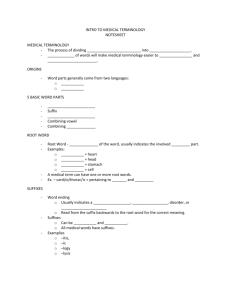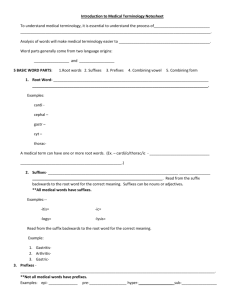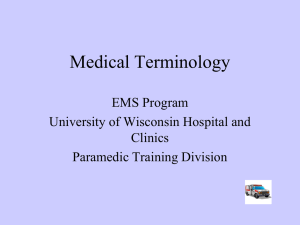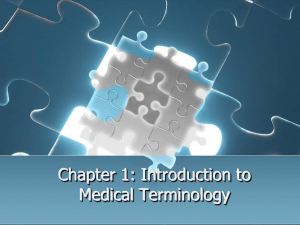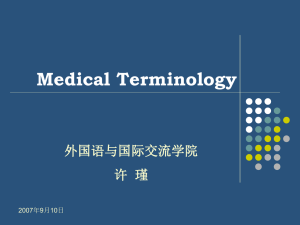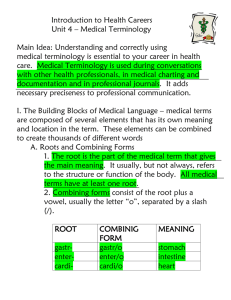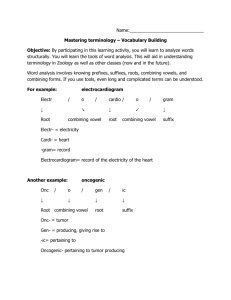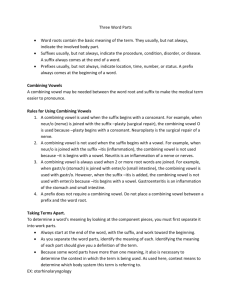pubdoc_12_27822_509
advertisement
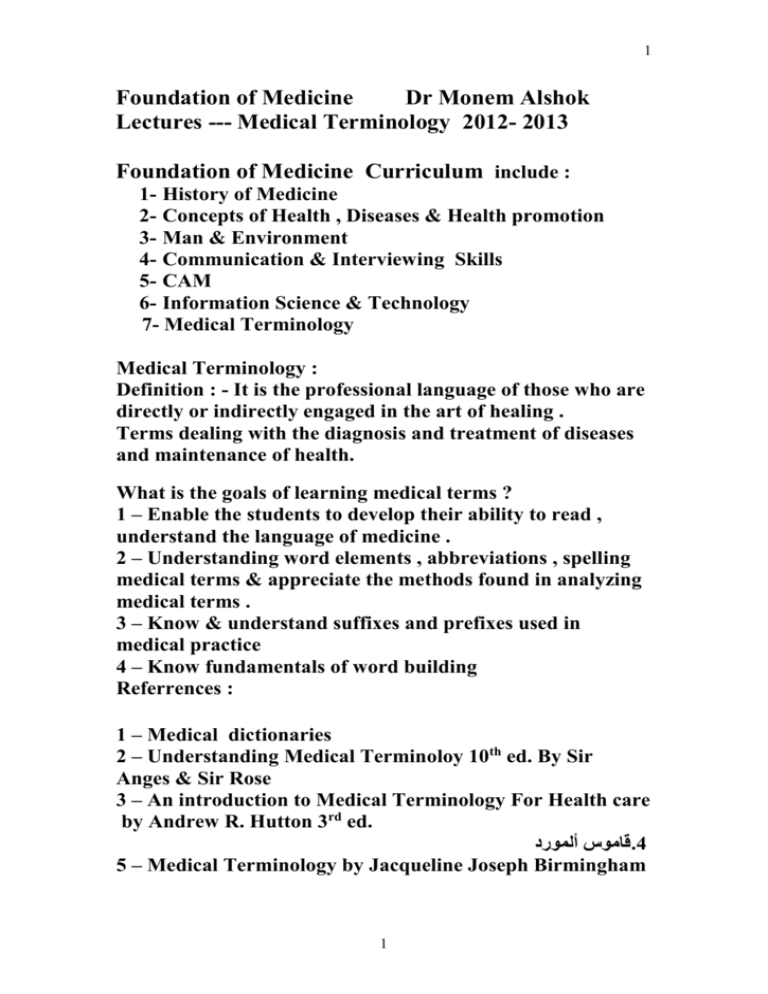
1 Foundation of Medicine Dr Monem Alshok Lectures --- Medical Terminology 2012- 2013 Foundation of Medicine Curriculum include : 1- History of Medicine 2- Concepts of Health , Diseases & Health promotion 3- Man & Environment 4- Communication & Interviewing Skills 5- CAM 6- Information Science & Technology 7- Medical Terminology Medical Terminology : Definition : - It is the professional language of those who are directly or indirectly engaged in the art of healing . Terms dealing with the diagnosis and treatment of diseases and maintenance of health. What is the goals of learning medical terms ? 1 – Enable the students to develop their ability to read , understand the language of medicine . 2 – Understanding word elements , abbreviations , spelling medical terms & appreciate the methods found in analyzing medical terms . 3 – Know & understand suffixes and prefixes used in medical practice 4 – Know fundamentals of word building Referrences : 1 – Medical dictionaries 2 – Understanding Medical Terminoloy 10th ed. By Sir Anges & Sir Rose 3 – An introduction to Medical Terminology For Health care by Andrew R. Hutton 3rd ed. قاموس ألمورد.4 5 – Medical Terminology by Jacqueline Joseph Birmingham 1 2 Introduction to Medical Terminology: Objectives: There are three objectives to keep in mind as you study medical Terminology : 1 . Analyze words by dividing them into component parts. 2 . Relate the medical terms to the structure and function of the human body. 3 . Be aware of spelling and pronunciation problems word Analysis The first job in learning the language is to understand how to divide words into their component parts. The medical language is logical in can be broken down ,that most terms, whether complex or simple into basic parts and then understood .For example: HEMAT-O-LOGY Root or Base Hemat Blood (HEMATOLOGY) Combining Form Element (O) Combining form element Suffix logy Science In general the objective of medical terminology iclude: Reviewing body systems and related medical terms Understanding how medical terms are formed including combining forms, prefixes and suffixes Learning to define, spell and pronounce medical terms according to the component word parts Forming a foundation that allows continuing expansion of medicla terminology skills Medical Terminology Mispronunciations: Artery - The study of fine paintings. Barium - What you do when CPR fails. Benign - What you are after you be eight. Coma - A punctuation mark. Morbid - A higher offer. Urine - opposite of you’re out. Tablet - A small table. 2 3 BASIC WORD STRUCTURE Approximately 75% of Medical Terms are based on either Greek or Latin Word Elements include : 1 . Root ( Base ): Foundation or core ,All medical words contain one or more. Conveys fundamental meaning, Example: HEPAT/ITIS "HEPAT" (liver) is the word root.means iflammation of the liver . It is the main part or main body or base of word , it may be complete word , but not necessirly a complete word and medical roots come from Latin & Greek , although many other languages could contribute . Examples : Tendonitis , Gastritis , Colloid , Mastectomy , Adenoma , Arthritis Word roots :Is the BASIC MEANING of the term. Usually indicate body part involved. Usually derived form Greek or Latin Frequently indicates a body part .Most medical terms have one or more word roots Cardi = heart Word root is the foundation of the word; It cannot stand alone. A suffix must be added. Word Parts Word roots in their combining form have a /vowel ,Cardi/o ,Neur/o ,Gastr/o. A combining vowel may be needed to make the medical term easier to pronounce .The letter O is the most commonly used combining vowel. Examples of Word Roods: Cardi = Heart , Nephr = Kidney , Gastr = stomach , Oste = bone, Haemat = blood , Hepat = Hepar or liver Word Roots Indicating Color: Cyanosis Cyan/o ( blue color of skin caused by lack of O2 ) + osis (condition) .Erythrocytes erythr/o (red) + cytes (cells) 3 4 Poliomyelitis Polio (gray) + myel (spinal cord) + itis (inflammation) Melano/o – black ( Melanocyte ) Combining Forms:Combining Form (CF) is a Word Root (WR) plus a vowel, usually an “o” Usually indicates a body part Combining Forms Examples: Cardi/ + o = cardi/o heart gastr/ + o = gastr/o stomach hepat/ + o = hepat/o liver nephr/ + o = nephr/o kidney oste/ + o = oste/o bone 2 . Suffix ( End ) Medical terms may/may not contain a suffix.Attached to the end of a word root.Alters or modifies the meaning. Suffix usually indicates a procedure, condition, disease, or part of speech . Usually derived from Greek or Latin. Example: HEPAT/ITIS "-ITIS" (inflammation) is the suffix. Arthrocentesis: puncture of a joint Arthr/o= joint -centesis = puncture throac/o chest -tomy incision gastr/o stomach -megaly enlargement Thoracotomy incision of the chest Gastromegaly enlargement of the stomach 3 .Prefix ( beginning ) Word element located at the beginning of a word .Changes the meaning of the word . Usually indicates a number, time, position, direction, color, or sense of negation 4 5 Attached to the beginning ,Influences the meaning. Not all medical terms contain a prefix Examples of Prefix: SUB / HEPAT /IC "SUB-" (under) is the prefix. ("-IC" is the suffix for pertaining to, subhepatic means pertaining to under the liver.) Prefix Root Amast without breast hyper- therm Suffix Medical Term -ia condition Amastia -ia Hyperthermia excessive heat condition intrain -ar Intramuscular relating to muscul muscle 4 . COMBINING VOWEL : vowel (usually o) that links the root to the suffix or the root to another root , makes the word easier to pronounce . We can say that COMBINING VOWEL Usually an “O” Links two word roots or a word root and a suffix Eases pronunciation Not all medical terms contain combining vowels .Has no meaning of its own. A word root which a vowel is attached is called a combining form Rules for Using Combining Vowels: 1st Rule A combing vowel, if used, is added to the end of the word root. 2nd Rule When connecting two word roots, a combining vowel is usually used even when vowels are present at the junction oste/o/arthr/itis, Cardi/o/myo/pathy , Cardi/o/Vascular, Hepat/o/renal 5 6 3rd Rule : When connecting a word root and a suffix, a combining vowel is usually not used if the suffix begins with a vowel - hepat/ic ,Another example of combing vowel not used if the suffix begins with a vowel. Neur/o + itis = neuritis. Stoma/o/itis, Nephr/o/it is ,Neur (nerve) = itis (inflammation). 4th Rule : A combining vowel is always used when 2 or more word roots are joined. Gastr/o (stomach) + enter/o (small intestine). = Gastroenteritis. 5th Rule: A prefix does not require a combining vowel. 6th Rule : A WR (word root) is used before a suffix that begins with a vowel. Scler/ + osis = sclerosis Hemat/ + emesis = Hematemesis 7th Rule : A combining vowel is used to link a Word Root ( W R ) to a suffix that begins with a consonant and to link a WR to another WR to form a compound word: colon/o + scope = colonscope osteo/ o/ chondr/ itis = osteochondritis Ophthalmoscope, Dermatoplasty, Sternoclavicular, Costochondral 5 . COMBINING FORM ( Root and Vowel ) : combining of the root and the combining vowel. made by adding a vowel to the word base or root The vowel ( o) is most frequently used and other vowels rarely used ( a, I , e and u ) and if the word end with a vowel in most cases another vowel is not added . It is important to know the differences between a vowel that is a combining form element and a vowel that is part of a root word e.g. Hemi means half , Hem( O ) means blood Root or Base Orth Bacteri Quadr Gastr Combining Form (O) (O) ( i) (O) Suffix Pedic genic plegic Tomy 6 7 Combining Form Aden(o) Meaning Terminology gland Adenitis Nephr(o) Derm(o) Kidney Skin Erythr(o) Leuc(o) Arthr(o) Angi(o) Acr(o) Red White Joint Vessel Extremity Adep(o) Oste(o) Fat bone Ophalm(o) eye Onc(o) cancer Carcin(o) Malignancy Neur(o) nerve Meaning Inflammation of gland Nephrology Study of kidney Dermal Pertaining to the skin Erythrocyte RBC Leucocyte WBC Arthralgia Joint pain Angiography Vessel picture Acromegaly Enlargement of extremity Adepose Fatty tissue Osteoblast Bone forming cell Ophthalmologist One who study eye disease Oncogenesis Producing cancer Carcinoma Malignant tumour Neuroma Tumour of the nerve BREAKDOWN of Medical Terms : Medical terms include pertinent word parts, not all the time,Breakdown can sometimes be misleading .Knowing the breakdown will help with the learning process . Breakdown alone will not always give you the meaning o the term.Useful tool for identifying procedure, anatomical site or condition. Examples The term Leukemia condition of LEUK/EMIA - literally means blood, white; actual meaning is large increase in the number of cancerous abnormal white blood cells AUT/O/PSY - literally means process of viewing self; actual meaning is exam of dead body (with one’s own eyes) to determine cause of death 7 8 Analyzing and Defining Medical terms are usually read “backwards” or suffix first Examples: HYPO GASTR IC Pertaining to below the stomach NEURO LOGY Study of Nerves Suffixes usually indicate the procedure, condition, disorder, or disease. Comes at END of word.or added to end of word. Cardiomyopathy = disease of heart muscle Pericardium = around the heart;Some suffixes change the word root into an adjective.: Cardiac cardi/o (heart) + ac (pertaining to). Some suffixes change the word root into a noun.Cranium crani (skull) + um (noun ending). Suffixes Meaning Abnormal Condition -osis means an abnormal condition or disease Gastrosis means any disease of the stomach ; Suffixes Related to Pathology -algia means pain Gastralgia , -dynia means pain, Gastrodynia , -itis means inflammation Gastritis , -malacia means abnormal softening = osteomalacia ; Suffixes Related to Pathology ,Megaly means enlargement +Hepatomegaly ,Necrosis means tissue death ,Arterionecrosis ,Sclerosis means abnormal hardening ,Arteriosclerosis ,Stenosis means abnormal narrowing Suffixes Related to Procedures , -centesis – surgical puncture to remove fluid Abdominocentisis ,-ectomy – surgical removal Appendectomy ,-graphy –means the process of recording a picture or record Arteriography-gram – means a record or picture , arteriogram The suffixes which have a Double RR : The Double RRs ( -rrhage and –rrhagia mean abnormal excessive fluid discharge or bleeding. Hemorrhage, menorrhagia ),(-rrhaphy – to stitch e.g. Herniorrhaphy ) (-rrhea – abnormal flow or discharge Diarrhea) ,(-rrhexis – rupture myorrexis ) 8 9 Set 1 : Suffixes which change a root word to an adjective Suffix - ac Meaning Pertaining to Terminology celiac - acy Pertaining to fallacy - al Pertaining to Digital - an - ary - ory - ous - ic - ose Pertaining to Pertaining to Pertaining to Pertaining to Pertaining to Having the quality Having the quality Having the quality like Like Causing to become or making That which performs ovarian biliary sensory venous Cephalic comatose -y - ile - oid - some - facient - ive 9 gouty Meaning P t abdominal region That which is false P t fingure or toe P t ovary P t bile P t senses P t vein P . t. head Coma( Loss of consciousness ) Gout like febrile feverish ameboid tiresome malifacient amoebalike tiring Causing illness tardive Late appearing 10 Set 2 : Suffixes which change the root to NOUN Suffix - cide meaning killer example Bacteriocide - poiesis hematopoiesis - ure Production or formation act - er One who radiographer - or One who receptor one who receive - form Shape ossiform - agogue Leading or inducing galactagogue - ectesia dilatation telangiectasia The shape or resembling bone Agent that promotes milk flow Dilatation of capillaries - sthenia strength Asthenia closure definition Killer of bacteria Production of blood cells Result of closing action One who take x ray Loss of strength Set 3 : Suffixes which denote state or condition Suffixes - vert - tion - algia - ia - osis - penia - stasis meaning turn Process of , act of or result of pain A disease condition Condition , action , state Lack or deficiency State of being at standstill example divert elongation Halitosis Definition Turn a side Process of making longer Nerve pain Condition of lack of urine Bad breath leukopenia Lack of WBC Hemostasis Stagnation of blood neuralgia anuria 10 11 Set 4 : Suffixes which indicate a Surgical or Diagnostic procedures Suffix - centesis Meaning Puncture of cavity Example paracentesis - desis fusion arthrodesis - cis - ectomy cut Cutting out or excision Creation of mouth or opening incision laryngectomy - ostomy colostomy Definition Puncture of space around an organ Fixation of joint Make a cut Removal of larynx Creating a new opening between bowel and abdominal wall ( - clasis, - clasia, - gram , - graphy , - lysis , - otomy , - pexy , - plasty , - rrhaphy , - scope, scopy, -sect , -tome ) Set 5 : Suffixes which indicate smallness ( Diminutive suffixes ) Suffix -cle -cule -culum -culus -et -ium -ole -olum -olus Example Caruncle Molecule Tuberculum calculus facet Bronchium arteriole mesenteriolum bronchiolus 11 Meaning Small fleshy growth Smallest part of atom Small nodule or knot Small stone Small plane surface Small bronchial tube Minute artery Small mesentery Smallest subdivision of bronchus 12 Set 6 : Word endings which indicate Plurals Singular -a Plural -ae -en -ex -ies -is -is -ina -ices -ietes -es -ides -ma -nx -on -s -u -um -mata -nges -a -tes -ua -a -us -us -us -x -era -i -ora -ces Example Lamina , laminae Scapula , scapulae Lumen , lumina Index , indeces Paries , parietes Psychosis, psychoses Epididymis, epididymdes Trauma , traumata Phalynx , phalynges Criterion , criteria Pons , pontes Cornu, cornua Diverticulum , diverticula Viscus , viscera Bacillus , bacilli Corpus , corpora Calyx, calyces Set 7 : some suffixes indicate chemical compound Examples: -Ol ( oil) = cholesterol, -ase ( enzyme ) = lipase , -ose ( carbohydrate ) = glucose 12 13 Tips for Success Attend EACH class Ask? if information unclear Read More Assess your self Complete homework before class Study ahead for each class 13
